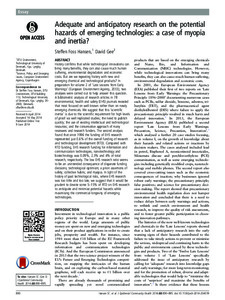Adequate and anticipatory research on the potential hazards of emerging technologies: a case of myopia and inertia?

Hansen, Steffen F. ; Gee, David
Journal of Epidemiology and Community Health
2014
68
9
890-895
chemicals ; precautionary principle ; research policy ; risk assessment ; technology ; nanotechnology
Risk assessment and risk management
http://dx.doi.org/10.1136/jech-2014-204019
English
Bibliogr.
"History confirms that while technological innovations can bring many benefits, they can also cause much human suffering, environmental degradation and economic costs. But are we repeating history with new and emerging chemical and technological products? In preparation for volume 2 of ‘Late Lessons from Early Warnings' (European Environment Agency, 2013), two analyses were carried out to help answer this question. A bibliometric analysis of research articles in 78 environmental, health and safety (EHS) journals revealed that most focused on well-known rather than on newly emerging chemicals. We suggest that this ‘scientific inertia' is due to the scientific requirement for high levels of proof via well replicated studies; the need to publish quickly; the use of existing intellectual and technological resources; and the conservative approach of many reviewers and research funders. The second analysis found that since 1996 the funding of EHS research represented just 0.6% of the overall funding of research and technological development (RTD). Compared with RTD funding, EHS research funding for information and communication technologies, nanotechnology and biotechnology was 0.09%, 2.3% and 4% of total research, respectively. The low EHS research ratio seems to be an unintended consequence of disparate funding decisions; technological optimism; a priori assertions of safety; collective hubris; and myopia. In light of the history of past technological risks, where EHS research was too little and too late, we suggest that it would be prudent to devote some 5–15% of RTD on EHS research to anticipate and minimise potential hazards while maximising the commercial longevity of emerging technologies. "
Digital
The ETUI is co-funded by the European Union. Views and opinions expressed are however those of the author(s) only and do not necessarily reflect those of the European Union or the ETUI.